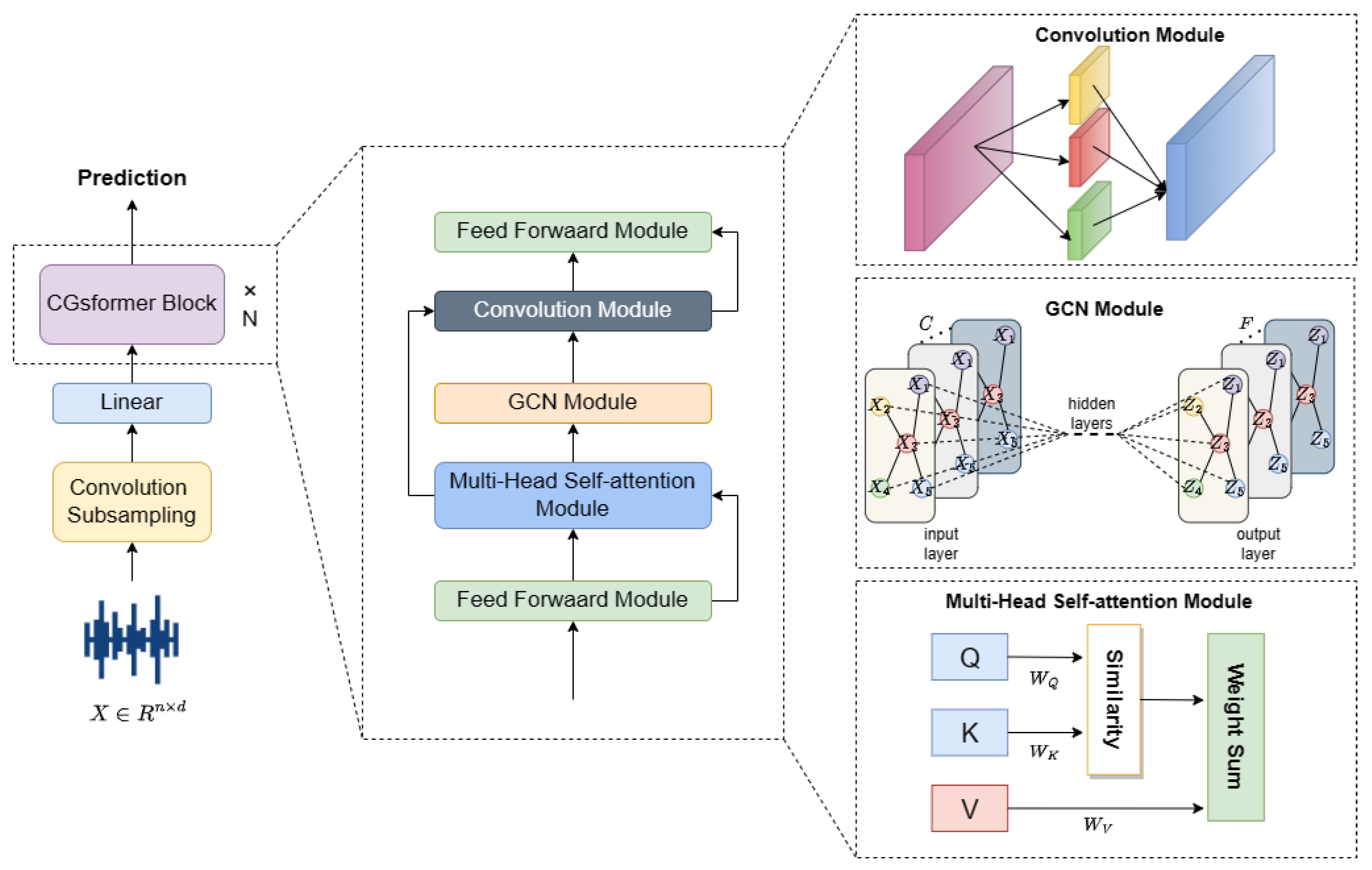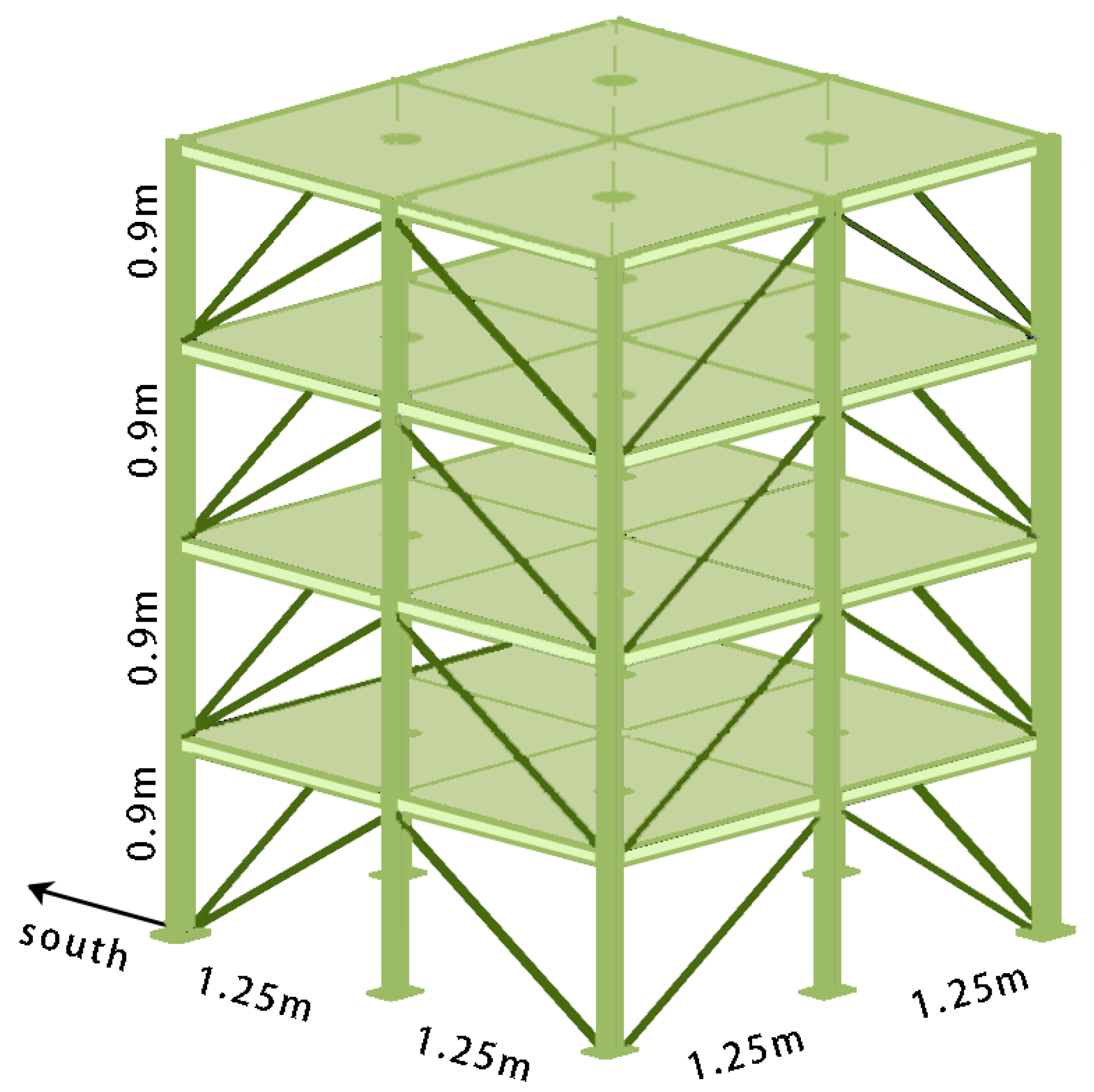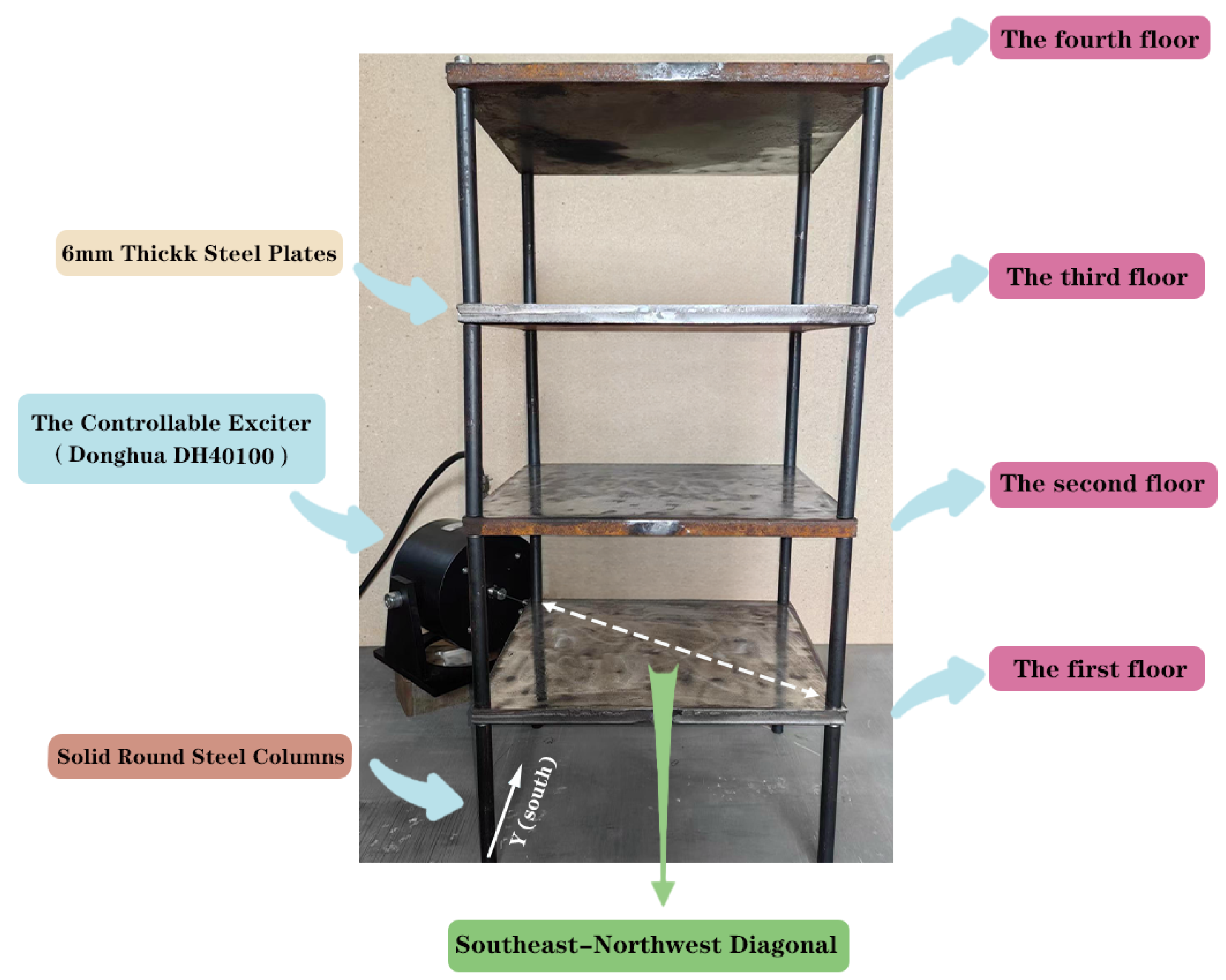Graph Feature Refinement and Fusion in Transformer for Structural Damage Detection
Abstract
:1. Introduction
2. Methodology
2.1. The Equation of Motion
2.2. Global and Local Feature Extraction
2.3. Graph Convolution Network
2.4. Extracting Robust Features via CGsformer
2.5. Prediction
3. Verification by Simulation
3.1. Test Setup and Data Preparation
3.2. Comparison with Other Models
- CNN [28]: In this experiment, a one-dimension (1D) convolution operation with two convolutional kernels of size five constructed the network.
- LSTM [33]: In this experiment, a bidirectional LSTM with two hidden layers and a dimension of 128 constructed the network.
- CNN-LSTM [37]: The spatial features were first extracted using a 1D CNN with a convolutional kernel size of 15, and then these features were input into a two-layer LSTM with a hidden layer dimension of 256 for temporal modeling.
- Multihead CNN [50]: Multihead CNN learns different-scale or different-type features by introducing multiple parallel convolutional branches. Each branch can focus on different spatial or frequency domain information, and their results are fused to more comprehensively describe structural damage information.
- Transformer [46]: In this experiment, four Transformer blocks were used with eight heads in the multiheaded attention mechanism, and the dimension was set to 512.
- Conformer [51]: Conformer combines the advantages of CNN and self-attention mechanisms, effectively handles long input sequences, and possesses strong modeling and contextual understanding capabilities. The experimental hyperparameter settings for Conformer were consistent with the CGsformer, as illustrated in Table 2.
3.3. Ablation Study
3.4. Comparative Analysis on the Four-Story Numerical Model with 24 Classifiers
4. Experimental Verfication
4.1. Experiment Description
4.2. Comparative Analysis of Models in the Experimental Structure
5. Conclusions
- The proposed damage detection model has demonstrated its feasibility in test setups with the IASC-ASCE simulated benchmark structure and a four-story, single-span, steel frame structure, thus achieving damage identification accuracies of 96.71% and 92.44%, respectively. These results not only validate the effectiveness of the CGsformer in identifying structural damage but also provide valuable insights for future research.
- The proposed CGsformer model exhibited high accuracy and robustness in limited datasets and noise-contaminated conditions. In the example of the IASC-ASCE benchmark structure, despite the noise level increasing from 0% to 50%, the detection accuracy only decreased by 1.81%. This means that the CGsformer can more effectively extract features from the acceleration response signal, thus showcasing strong noise resistance.
Author Contributions
Funding
Institutional Review Board Statement
Informed Consent Statement
Data Availability Statement
Conflicts of Interest
References
- Fan, W.; Qiao, P. Vibration-based damage identification methods: A review and comparative study. Struct. Health Monit. 2011, 10, 83–111. [Google Scholar] [CrossRef]
- Aabid, A.; Parveez, B.; Raheman, M.A.; Ibrahim, Y.E.; Anjum, A.; Hrairi, M.; Parveen, N.; Mohammed Zayan, J. A review of piezoelectric material-based structural control and health monitoring techniques for engineering structures: Challenges and opportunities. Actuators 2021, 10, 101. [Google Scholar] [CrossRef]
- Xiao, F.; Hulsey, J.L.; Balasubramanian, R. Fiber optic health monitoring and temperature behavior of bridge in cold region. Struct. Control Health Monit. 2017, 24, e2020. [Google Scholar] [CrossRef]
- Gkoumas, K.; dos Santos, F.; Pekar, F. Research in bridge maintenance, safety and management: An overview and outlook for europe. In Bridge Maintenance, Safety, Management, Life-Cycle Sustainability and Innovations; CRC Press: Boca Raton, FL, USA, 2021; pp. 1755–1761. [Google Scholar]
- Malla, P.; Khedmatgozar Dolati, S.S.; Ortiz, J.D.; Mehrabi, A.B.; Nanni, A.; Ding, J. Damage detection in frp-reinforced concrete elements. Materials 2024, 17, 1171. [Google Scholar] [CrossRef] [PubMed]
- Tang, Q.; Xin, J.; Jiang, Y.; Zhang, H.; Zhou, J. Dynamic Response Recovery of Damaged Structures Using Residual Learning Enhanced Fully Convolutional Network. Int. J. Struct. Stab. Dyn. 2024, 2550008. [Google Scholar] [CrossRef]
- Lucà, F.; Manzoni, S.; Cerutti, F.; Cigada, A. A damage detection approach for axially loaded beam-like structures based on gaussian mixture model. Sensors 2022, 22, 8336. [Google Scholar] [CrossRef] [PubMed]
- Azimi, M.; Eslamlou, A.D.; Pekcan, G. Data-driven structural health monitoring and damage detection through deep learning: State-of-the-art review. Sensors 2020, 20, 2778. [Google Scholar] [CrossRef]
- Dao, P.B.; Staszewski, W.J. Lamb wave based structural damage detection using stationarity tests. Materials 2021, 14, 6823. [Google Scholar] [CrossRef] [PubMed]
- Xiao, F.; Sun, H.; Mao, Y.; Chen, G.S. Damage identification of large-scale space truss structures based on stiffness separation method. Structures 2023, 53, 109–118. [Google Scholar] [CrossRef]
- Tong, K.; Zhang, H.; Zhao, R.; Zhou, J.; Ying, H. Investigation of smfl monitoring technique for evaluating the load-bearing capacity of rc bridges. Eng. Struct. 2023, 293, 116667. [Google Scholar] [CrossRef]
- Angeletti, F.; Iannelli, P.; Gasbarri, P.; Panella, M.; Rosato, A. A study on structural health monitoring of a large space antenna via distributed sensors and deep learning. Sensors 2022, 23, 368. [Google Scholar] [CrossRef]
- Altabey, W.A.; Wu, Z.; Noori, M.; Fathnejat, H. Structural health monitoring of composite pipelines utilizing fiber optic sensors and an ai-based algorithm—A comprehensive numerical study. Sensors 2023, 23, 3887. [Google Scholar] [CrossRef]
- Kot, P.; Muradov, M.; Gkantou, M.; Kamaris, G.S.; Hashim, K.; Yeboah, D. Recent advancements in non-destructive testing techniques for structural health monitoring. Appl. Sci. 2021, 11, 2750. [Google Scholar] [CrossRef]
- Hassani, S.; Dackermann, U. A systematic review of advanced sensor technologies for non-destructive testing and structural health monitoring. Sensors 2023, 23, 2204. [Google Scholar] [CrossRef]
- Hou, R.; Xia, Y. Review on the new development of vibration-based damage identification for civil engineering structures: 2010–2019. J. Sound Vib. 2021, 491, 115741. [Google Scholar]
- Xiao, F.; Hulsey, J.L.; Chen, G.S.; Xiang, Y. Optimal static strain sensor placement for truss bridges. Int. J. Distrib. Sens. Netw. 2017, 13, 5. [Google Scholar]
- Avci, O.; Abdeljaber, O.; Kiranyaz, S.; Hussein, M.; Gabbouj, M.; Inman, D.J. A review of vibration-based damage detection in civil structures: From traditional methods to machine learning and deep learning applications. Mech. Syst. Signal Process. 2021, 147, 107077. [Google Scholar]
- Nick, H.; Aziminejad, A.; Hosseini, M.H.; Laknejadi, K. Damage identification in steel girder bridges using modal strain energy-based damage index method and artificial neural network. Eng. Fail. Anal. 2021, 119, 105010. [Google Scholar]
- Fallahian, M.; Ahmadi, E.; Khoshnoudian, F. A structural damage detection algorithm based on discrete wavelet transform and ensemble pattern recognition models. J. Civ. Struct. Health Monit. 2022, 12, 323–338. [Google Scholar]
- Indhu, R.; Sundar, G.R.; Parveen, H.S. A review of machine learning algorithms for vibration-based shm and vision-based shm. In Proceedings of the 2022 Second International Conference on Artificial Intelligence and Smart Energy (ICAIS), Coimbatore, India, 23–25 February 2022; pp. 418–422. [Google Scholar]
- Zhang, J.; Sato, T.; Iai, S. Support vector regression for on-line health monitoring of large-scale structures. Struct. Saf. 2006, 28, 392–406. [Google Scholar] [CrossRef]
- Hua, X.; Ni, Y.; Ko, J.; Wong, K. Modeling of temperature–frequency correlation using combined principal component analysis and support vector regression technique. J. Comput. Civ. Eng. 2007, 21, 122–135. [Google Scholar]
- Salkhordeh, M.; Mirtaheri, M.; Soroushian, S. A decision-tree-based algorithm for identifying the extent of structural damage in braced-frame buildings. Struct. Control Health Monit. 2021, 28, e2825. [Google Scholar]
- Wang, Y.; Su, F.; Guo, Y.; Yang, H.; Ye, Z.; Wang, L. Predicting the microbiologically induced concrete corrosion in sewer based on xgboost algorithm. Case Stud. Constr. Mater. 2022, 17, e01649. [Google Scholar]
- Lingxin, Z.; Junkai, S.; Baijie, Z. A review of the research and application of deep learning-based computer vision in structural damage detection. Earthq. Eng. Eng. Vib. 2022, 21, 1–21. [Google Scholar]
- Eltouny, K.; Gomaa, M.; Liang, X. Unsupervised learning methods for data-driven vibration-based structural health monitoring: A review. Sensors 2023, 23, 3290. [Google Scholar] [CrossRef] [PubMed]
- Abdeljaber, O.; Avci, O.; Kiranyaz, S.; Gabbouj, M.; Inman, D.J. Real-time vibration-based structural damage detection using one-dimensional convolutional neural networks. J. Sound Vib. 2017, 388, 154–170. [Google Scholar]
- Zhang, Y.; Miyamori, Y.; Mikami, S.; Saito, T. Vibration-based structural state identification by a 1-dimensional convolutional neural network. Comput.-Aided Civ. Infrastruct. Eng. 2019, 34, 822–839. [Google Scholar]
- Khodabandehlou, H.; Pekcan, G.; Fadali, M.S. Vibration-based structural condition assessment using convolution neural networks. Struct. Control Health Monit. 2019, 26, e2308. [Google Scholar]
- Tang, Z.; Chen, Z.; Bao, Y.; Li, H. Convolutional neural network-based data anomaly detection method using multiple information for structural health monitoring. Struct. Control Health Monit. 2019, 26, e2296. [Google Scholar]
- Mantawy, I.M.; Mantawy, M.O. Convolutional neural network based structural health monitoring for rocking bridge system by encoding time-series into images. Struct. Control Health Monit. 2022, 29, e2897. [Google Scholar]
- Lin, Z.; Liu, Y.; Zhou, L. Damage detection in a benchmark structure using long short-term memory networks. In Proceedings of the 2019 Chinese Automation Congress (CAC), Hangzhou, China, 22–24 November 2019; pp. 2300–2305. [Google Scholar]
- Sony, S.; Gamage, S.; Sadhu, A.; Samarabandu, J. Vibration-based multiclass damage detection and localization using long short-term memory networks. Structures 2022, 35, 436–451. [Google Scholar] [CrossRef]
- Zou, J.; Yang, J.; Wang, G.; Tang, Y.; Yu, C. Bridge structural damage identification based on parallel cnn-gru. IOP Conf. Ser. Earth Environ. Sci. 2021, 626, 012017. [Google Scholar] [CrossRef]
- Yang, J.; Yang, F.; Zhou, Y.; Wang, D.; Li, R.; Wang, G.; Chen, W. A data-driven structural damage detection framework based on parallel convolutional neural network and bidirectional gated recurrent unit. Inf. Sci. 2021, 566, 103–117. [Google Scholar] [CrossRef]
- Bao, X.; Fan, T.; Shi, C.; Yang, G. Deep learning methods for damage detection of jacket-type offshore platforms. Process Saf. Environ. Prot. 2021, 154, 249–261. [Google Scholar] [CrossRef]
- Fu, L.; Tang, Q.; Gao, P.; Xin, J.; Zhou, J. Damage identification of long-span bridges using the hybrid of convolutional neural network and long short-term memory network. Algorithms 2021, 14, 180. [Google Scholar] [CrossRef]
- Dang, V.-H.; Vu, T.-C.; Nguyen, B.-D.; Nguyen, Q.-H.; Nguyen, T.-D. Structural damage detection framework based on graph convolutional network directly using vibration data. Structures 2022, 38, 40–51. [Google Scholar] [CrossRef]
- Wang, S.; Luo, Z.; Shen, P.; Zhang, H.; Ni, Z. Graph-in-graph convolutional network for ultrasonic guided wave-based damage detection and localization. IEEE Trans. Instrum. Meas. 2022, 71, 2502011. [Google Scholar] [CrossRef]
- Zhan, P.; Qin, X.; Zhang, Q.; Sun, Y. A novel structural damage detection method via multi-sensor spatial-temporal graph-based features and deep graph convolutional network. IEEE Trans. Instrum. Meas. 2023, 72, 2504814. [Google Scholar] [CrossRef]
- Liang, Z.; Li, D.; Ren, W. Structural damage identification method based on recursive graph for automatic feature extraction. In Proceedings of the 29th National Conference on Structural Engineering (Volume II), Wuhan, China, 16–18 October 2020. [Google Scholar]
- Johnson, E.A.; Lam, H.-F.; Katafygiotis, L.S.; Beck, J.L. Phase i iasc-asce structural health monitoring benchmark problem using simulated data. J. Eng. Mech. 2004, 130, 3–15. [Google Scholar] [CrossRef]
- Hwang, H.; Kim, C. Damage detection in structures using a few frequency response measurements. J. Sound Vib. 2004, 270, 1–14. [Google Scholar] [CrossRef]
- Yessoufou, F.; Zhu, J. Classification and regression-based convolutional neural network and long short-term memory configuration for bridge damage identification using long-term monitoring vibration data. Struct. Health Monit. 2023, 22, 14759217231161811. [Google Scholar] [CrossRef]
- Vaswani, A.; Shazeer, N.; Parmar, N.; Uszkoreit, J.; Jones, L.; Gomez, A.N.; Kaiser, Ł.; Polosukhin, I. Attention is all you need. In Proceedings of the Annual Conference on Neural Information Processing Systems 2017, Long Beach, CA, USA, 4–9 December 2017. [Google Scholar]
- Dai, Z.; Yang, Z.; Yang, Y.; Carbonell, J.; Le, Q.V.; Salakhutdinov, R. Transformer-xl: Attentive language models beyond a fixed-length context. arXiv 2019, arXiv:1901.02860. [Google Scholar]
- Zhang, Z.; Cui, P.; Zhu, W. Deep Learning on Graphs: A Survey. IEEE Trans. Knowl. Data Eng. 2020, 34, 249–270. [Google Scholar] [CrossRef]
- Chen, F. Improvement of Kalman Filter and Kalman Estimator in the Application of Structural Damage Detection. Ph.D. Thesis, Xiamen University, Xiamen, China, 2014. [Google Scholar]
- Junior, R.F.R.; dos Santos Areias, I.A.; Campos, M.M.; Teixeira, C.E.; da Silva, L.E.B.; Gomes, G.F. Fault detection and diagnosis in electric motors using 1d convolutional neural networks with multi-channel vibration signals. Measurement 2022, 190, 110759. [Google Scholar] [CrossRef]
- Gulati, A.; Qin, J.; Chiu, C.-C.; Parmar, N.; Zhang, Y.; Yu, J.; Han, W.; Wang, S.; Zhang, Z.; Wu, Y.; et al. Conformer: Convolution-augmented transformer for speech recognition. arXiv 2020, arXiv:2005.08100. [Google Scholar]
















| Damage Pattern | Pattern Description |
|---|---|
| D.P.0 | No damage. |
| D.P.1 | All braces on the first floor have no stiffness. |
| D.P.2 | All braces on the first and third floors have no stiffness. |
| D.P.4 | One brace of the first floor and the third floor has no stiffness. |
| Setting | Value |
|---|---|
| Encoder Layers | 4 |
| Encoder Dim | 512 |
| Attention Heads | 2 |
| Conv Kernel Size | 19 |
| Multihead Attention Dropout | 0.4 |
| CGsformer Dropout | 0.1 |
| Method | ACC | |
|---|---|---|
| CNN | 0.8910 | 0.8903 |
| LSTM | 0.8822 | 0.8826 |
| CNN-LSTM | 0.9255 | 0.9258 |
| Multihead CNN | 0.9239 | 0.9238 |
| Transformer | 0.9407 | 0.9406 |
| Conformer | 0.9527 | 0.9528 |
| CGsformer | 0.9671 | 0.9672 |
| Model | ACC | CI | ||
|---|---|---|---|---|
| CNN | 0.8910 | 0.0761 | [0.8724, 0.9078] | [0.0562, 0.0960] |
| LSTM | 0.8822 | 0.0849 | [0.8630, 0.8996] | [0.0645, 0.1053] |
| CNN-LSTM | 0.9255 | 0.0416 | [0.9104, 0.9402] | [0.0240, 0.0592] |
| Multihead CNN | 0.9239 | 0.0432 | [0.9086, 0.9387] | [0.0255, 0.0609] |
| Transformer | 0.9407 | 0.0264 | [0.9261, 0.9532] | [0.0100, 0.0428] |
| Conformer | 0.9527 | 0.0144 | [0.9394, 0.9638] | [−0.0010, 0.0298] |
| CGsformer | 0.9671 | - | [0.9557, 0.9763] | - |
| Method | ACC | |
|---|---|---|
| Conformer | 0.9527 | 0.9528 |
| CGsformer | 0.9671 | 0.9672 |
| Attention Before | 0.9631 | 0.9632 |
| Convolution After | 0.9623 | 0.9623 |
| Direction/Floor | Noise 0% | Noise 20% | Noise 50% |
|---|---|---|---|
| First Floor, x direction | 0.9671 | 0.9607 | 0.9279 |
| First Floor, y direction | 0.9688 | 0.9712 | 0.9375 |
| Second Floor, x direction | 0.9776 | 0.9704 | 0.9583 |
| Second Floor, y direction | 0.9816 | 0.9752 | 0.9391 |
| Third Floor, x direction | 0.9824 | 0.9631 | 0.9383 |
| Third Floor, y direction | 0.9671 | 0.9535 | 0.9191 |
| Fourth Floor, x direction | 0.9575 | 0.9607 | 0.9543 |
| Fourth Floor, y direction | 0.9776 | 0.9832 | 0.9615 |
| Average | 0.9725 | 0.9674 | 0.9544 |
| Damage Case | Description |
|---|---|
| D.P.0 | Without damage (The columns at the southeast corner of floors 1–4 all have a diameter of 16 mm) |
| D.P.1 | Replaced the column on the first floor with a 14 mm diameter column. |
| D.P.2 | Replaced the column on the second floor with a 14 mm diameter column. |
| D.P.3 | Replaced the column on the third floor with a 14 mm diameter column. |
| D.P.4 | Replaced the column on the forth floor with a 14 mm diameter column. |
| D.P.5 | Replaced the columns on the first and second floors with 14 mm and 12 mm diameter columns, respectively |
| Floor/Direction | CNN | LSTM | Transformer | Conformer | CGsformer |
|---|---|---|---|---|---|
| First Floor, x direction | 80.98 | 84.45 | 89.52 | 91.18 | 93.16 |
| First Floor, y direction | 77.78 | 82.10 | 87.01 | 93.37 | 93.91 |
| Second Floor, x direction | 76.01 | 86.59 | 86.43 | 91.93 | 92.97 |
| Second Floor, y direction | 82.05 | 84.93 | 87.23 | 93.48 | 93.56 |
| Third Floor, x direction | 81.20 | 83.60 | 84.61 | 88.67 | 90.03 |
| Third Floor, y direction | 76.33 | 86.37 | 85.95 | 91.72 | 92.25 |
| Forth Floor, x direction | 74.47 | 79.22 | 88.19 | 91.93 | 91.83 |
| Forth Floor, y direction | 78.63 | 84.13 | 91.82 | 91.40 | 92.20 |
| Average | 78.43 | 83.92 | 87.60 | 91.71 | 92.44 |
Disclaimer/Publisher’s Note: The statements, opinions and data contained in all publications are solely those of the individual author(s) and contributor(s) and not of MDPI and/or the editor(s). MDPI and/or the editor(s) disclaim responsibility for any injury to people or property resulting from any ideas, methods, instructions or products referred to in the content. |
© 2024 by the authors. Licensee MDPI, Basel, Switzerland. This article is an open access article distributed under the terms and conditions of the Creative Commons Attribution (CC BY) license (https://creativecommons.org/licenses/by/4.0/).
Share and Cite
Hu, T.; Ma, K.; Xiao, J. Graph Feature Refinement and Fusion in Transformer for Structural Damage Detection. Sensors 2024, 24, 4415. https://doi.org/10.3390/s24134415
Hu T, Ma K, Xiao J. Graph Feature Refinement and Fusion in Transformer for Structural Damage Detection. Sensors. 2024; 24(13):4415. https://doi.org/10.3390/s24134415
Chicago/Turabian StyleHu, Tianjie, Kejian Ma, and Jianchun Xiao. 2024. "Graph Feature Refinement and Fusion in Transformer for Structural Damage Detection" Sensors 24, no. 13: 4415. https://doi.org/10.3390/s24134415
APA StyleHu, T., Ma, K., & Xiao, J. (2024). Graph Feature Refinement and Fusion in Transformer for Structural Damage Detection. Sensors, 24(13), 4415. https://doi.org/10.3390/s24134415









